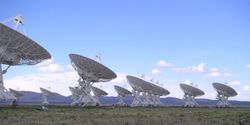
Organisation Européenne pour la Recherche Nucléaire
The European Organization for Nuclear Research (French: Organisation européenne pour la recherche nucléaire), commonly known as CERN is the world's largest particle physics laboratory, situated just northwest of Geneva on the border between France and Switzerland. The convention establishing CERN was signed on 29 September 1954. From the original 12 signatories of the CERN convention, membership has grown to the present 20 member states. Its main function is to provide the particle accelerators and other infrastructure needed for high-energy physics research. Numerous experiments have been constructed at CERN by international collaborations to make use of them.

The main site at Meyrin also has a large computer centre containing very powerful data processing facilities primarily for experimental data analysis, and because of the need to make them available to researchers elsewhere, has historically been (and continues to be) a major wide area networking hub.
CERN currently has approximately 2600 full-time employees. Some 7931 scientists and engineers (representing 500 universities and 80 nationalities), about half of the world's particle physics community, work on experiments conducted at CERN.

Several important achievements in particle physics have been made during experiments at CERN. These include, but are not limited to:
* 1973: The discovery of neutral currents in the Gargamelle bubble chamber.
* 1983: The discovery of W and Z bosons in the UA1 and UA2 experiments.
* 1995: The first creation of antihydrogen atoms in the PS210 experiment.
* 2001: The discovery of direct CP-violation in the NA48 experiments.













































